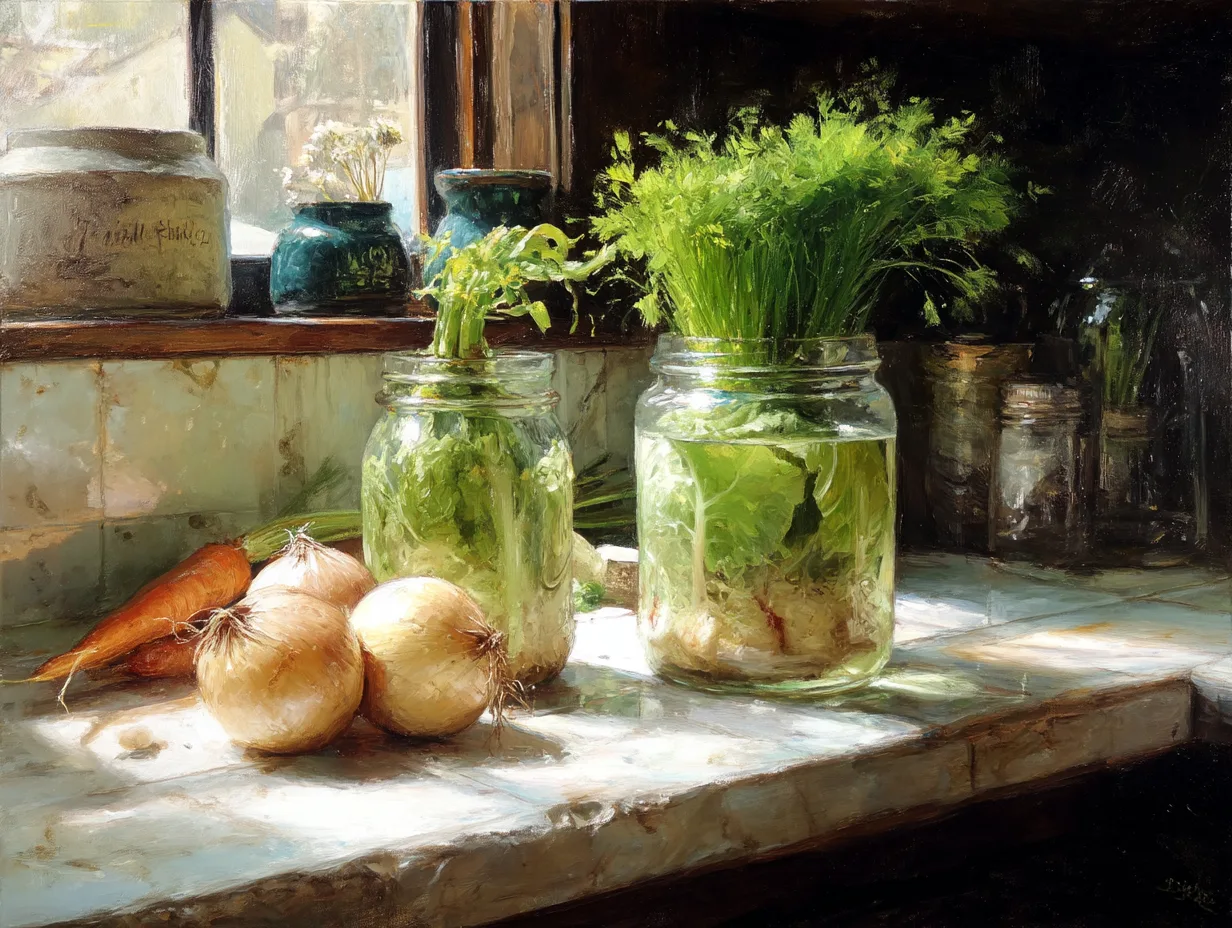Reduce Waste and Replant Kitchen Leftovers
Why toss your kitchen scraps in the trash when you can regrow them into fresh vegetables right at home? Growing Vegetables from Scraps not only cuts down on food waste but also offers a fun, cost-effective way to keep your kitchen supplied with herbs and produce year-round. Whether you live in a small apartment or have ample outdoor space, many vegetables can regenerate from leftovers like roots, stems, and even leaf trimmings.
In this guide, we’ll show you how to repurpose common kitchen scraps—such as celery bottoms, lettuce stumps, and herb cuttings—into thriving new plants. Along the way, we’ll point you to helpful resources for advanced tips, including the treasure trove of gardening wisdom found in The Year-Round Vegetable Garden for Beginners.
Why Regrow Vegetables from Scraps?
- Reduce Food Waste: Give kitchen leftovers a second life instead of sending them to the landfill.
- Save Money: Grow your own produce without buying seeds or transplants.
- Sustainability: Lower your carbon footprint by minimizing transportation and packaging waste.
- Educational Fun: Kids and adults alike can learn about plant biology and sustainable living.
For more eco-friendly gardening tips, see Efficient Watering Techniques for Sustainable Vegetable Gardening.
Best Kitchen Scraps to Regrow
Although many vegetables can be regrown, these are some of the easiest and most rewarding:
- Celery: Cut off the bottom two inches from a celery bunch and place it in water until new leaves appear.
- Lettuce and Bok Choy: Use the base of the head, placing it in water to regrow fresh leaves.
- Green Onions: Snip off the white bulbs with roots and replant them or keep them in water.
- Garlic: Plant individual cloves to grow new bulbs or regrow garlic greens.
- Carrot Tops: Though you won’t get new carrots, the leafy greens are edible and can be used like parsley.
- Potatoes: Use potato eyes to grow new plants, ensuring they have enough sprout growth.
For a deeper dive on each vegetable’s specific needs, check out our Vegetable Gardening for Beginners post.
Step-by-Step Regrowing Methods
1. The Water Method
- Gather Scraps: Save the bottom or root portion.
- Place in Water: Use a dish or glass to hold the scrap. Ensure the root end is submerged, but leaves remain above the water.
- Find the Right Light: Most plants need bright, indirect sunlight. A windowsill works well.
- Change Water Regularly: Replace with fresh water every couple of days to prevent mold or bacterial growth.
- Transplant: After new roots form (or greens appear), move the scrap to a pot or garden bed.
2. Direct Planting
- Prep the Scrap: For items like potato eyes or garlic cloves, allow them to sprout.
- Soil Setup: Use a well-draining potting mix or amend your garden soil with compost.
- Plant the Scrap: Bury it with the sprout or eye facing upward.
- Water and Mulch: Keep the soil consistently moist but not waterlogged. Mulch helps retain moisture.
This approach works best for root crops like garlic or potatoes, which need ample soil to grow to full size.
Essential Tips for Success
Lighting and Temperature
- Bright Windowsills: Place jars or pots in a sunny location, such as a south-facing window.
- Avoid Extreme Temperatures: Too much heat can cause rapid water evaporation, while cold drafts can stunt growth.
Water Quality
- Filtered or Tap Water?: Most scraps do well in standard tap water, but if you have heavily chlorinated water, consider letting it sit out overnight.
- Watch for Algae: If water turns green, rinse the container and replace it.
Soil Health
- Nutrient-Rich Soil: Over time, transfer scraps to a pot or garden bed with compost-enriched soil for long-term growth.
- Avoid Overcrowding: Give plants room to develop proper root systems. For more on soil management, check The Science of Soil.
Pest Control
- Natural Methods: Handpick pests or use homemade sprays. Learn more in Eco-Friendly Pest Control.
- Clean Containers: Sterilize jars or pots if you notice any mold or fungi developing.
Transitioning to Outdoors
While some scraps can live happily on a sunny windowsill, you may want to move them outside for a more robust harvest.
- Hardening Off: If grown indoors, gradually expose them to outdoor conditions over a week.
- Soil Preparation: Mix compost into your garden bed or use a quality potting mix in containers.
- Water Wisely: Newly transplanted plants need consistent watering until they establish strong roots.
- Sun Exposure: Monitor how the plants respond. Some may prefer partial shade, especially in hot climates.
Culinary Uses
Replanting scraps doesn’t always yield a full-size head of lettuce or a giant bulb of garlic, but you can still enjoy fresh flavors:
- Microgreens: Harvest young shoots for a concentrated nutrient punch.
- Green Tops: Use garlic greens, carrot tops, or green onion shoots in soups, salads, and stir-fries.
- Herbal Garnishes: Snip new leaves from basil, cilantro, or parsley scraps for garnishing dishes.
Experiment with different recipes to make the most of your regrown produce.
Common Challenges
- Slow Growth: Lack of adequate sunlight or nutrients can delay development.
- Rotting: Keeping scraps in water too long can cause decay. Transplant them before they break down.
- Limited Yield: Regrown veggies might not match store-bought size. Consider this a bonus harvest, not a full replacement.
Combining Kitchen Scraps with Other Gardening Methods
Growing vegetables from scraps can complement various gardening styles:
- Raised Row Gardening: For ample space and drainage, see our Raised Row Gardening post.
- No-Dig Gardening: Gentle on delicate roots, perfect for transplanted scraps.
- Container Gardening: Ideal for small spaces or apartments.
Final Thoughts
Regrowing vegetables from scraps is an accessible, eco-friendly way to embrace gardening. It reduces waste, saves money, and offers a rewarding glimpse into the plant life cycle. While not every scrap will flourish, the process is low-risk and often yields delicious results. Remember that these regrown plants may not always produce a full harvest, but they still provide fresh ingredients and valuable gardening experience.
For more in-depth guidance on sustainable gardening techniques, be sure to explore The Year-Round Vegetable Garden for Beginners. You’ll discover a wealth of knowledge to help you fine-tune your approach, whether you’re aiming for a lush backyard plot or a simple windowsill garden filled with vibrant, regrown veggies.


Leave a Reply